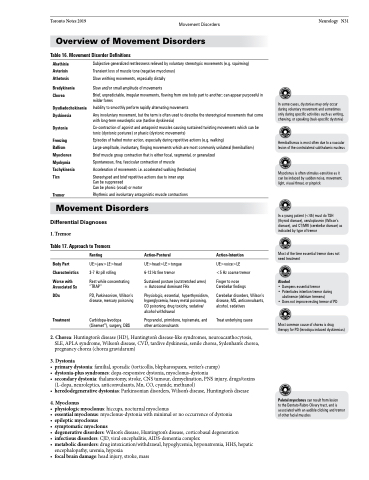Page 773 - TNFlipTest
P. 773
Toronto Notes 2019 Movement Disorders Overview of Movement Disorders
Table 16. Movement Disorder Definitions
Neurology N31
In some cases, dystonias may only occur during voluntary movement and sometimes only during specific activities such as writing, chewing, or speaking (task-specific dystonia)
Hemiballismus is most often due to a vascular lesion of the contralateral subthalamic nucleus
Myoclonus is often stimulus-sensitive as it can be induced by sudden noise, movement, light, visual threat, or pinprick
In a young patient (<45) must do TSH (thyroid disease), ceruloplasmin (Wilson’s disease), and CT/MRI (cerebellar disease) as indicated by type of tremor
Most of the time essential tremor does not need treatment
Alcohol
• Dampens essential tremor
• Potentiates intention tremor during
abstinence (delirium tremens)
• Does not improve resting tremor of PD
Most common cause of chorea is drug therapy for PD (levodopa induced dyskinesias)
Palatal myoclonus can result from lesion
to the Dentato-Rubro-Olivary tract, and is associated with an audible clicking and tremor of other facial muscles
Akathisia Asterixis Athetosis
Bradykinesia Chorea
Dysdiadochokinesia Dyskinesia
Dystonia
Freezing Ballism Myoclonus Myokymia Tachykinesia Tics
Tremor
Subjective generalized restlessness relieved by voluntary stereotypic movements (e.g. squirming) Transient loss of muscle tone (negative myoclonus)
Slow writhing movements, especially distally
Slow and/or small amplitude of movements
Brief, unpredictable, irregular movements, flowing from one body part to another; can appear purposeful in milder forms
Inability to smoothly perform rapidly alternating movements
Any involuntary movement, but the term is often used to describe the stereotypical movements that come with long-term neuroleptic use (tardive dyskinesia)
Co-contraction of agonist and antagonist muscles causing sustained twisting movements which can be tonic (dystonic postures) or phasic (dystonic movements)
Episodes of halted motor action, especially during repetitive actions (e.g. walking)
Large-amplitude, involuntary, flinging movements which are most commonly unilateral (hemiballism)
Brief muscle group contraction that is either focal, segmental, or generalized
Spontaneous, fine, fascicular contraction of muscle
Acceleration of movements i.e. accelerated walking (festination)
Stereotyped and brief repetitive actions due to inner urge Can be suppressed
Can be phonic (vocal) or motor
Rhythmic and involuntary antagonistic muscle contractions
Movement Disorders
Differential Diagnoses
1. Tremor
Table 17. Approach to Tremors
Body Part Characteristics
Worse with Associated Sx
DDx
Treatment
Resting
UE>jaw>LE>head 3-7 Hz pill rolling
Rest while concentrating “TRAP”
PD, Parkinsonism, Wilson’s disease, mercury poisoning
Carbidopa-levodopa (Sinemet®), surgery, DBS
Action-Postural
UE>head>LE>tongue 6-12 Hz fine tremor
Sustained posture (outstretched arms) ± Autosomal dominant FHx
Physiologic, essential, hyperthyroidism, hyperglycemia, heavy metal poisoning, CO poisoning, drug toxicity, sedative/ alcohol withdrawal
Propranolol, primidone, topiramate, and other anticonvulsants
Action-Intention
UE>voice>LE
<5 Hz coarse tremor
Finger to nose Cerebellar findings
Cerebellar disorders, Wilson’s disease, MS, anticonvulsants, alcohol, sedatives
Treat underlying cause
2. Chorea: Huntington’s disease (HD), Huntington’s disease-like syndromes, neuroacanthocytosis, SLE, APLA syndrome, Wilson’s disease, CVD, tardive dyskinesia, senile chorea, Sydenham’s chorea, pregnancy chorea (chorea gravidarum)
3. Dystonia
• primarydystonia:familial,sporadic(torticollis,blepharospasm,writer’scramp)
• dystonia-plussyndromes:dopa-responsivedystonia,myoclonus-dystonia
• secondarydystonia:thalamotomy,stroke,CNStumour,demyelination,PNSinjury,drugs/toxins
(L-dopa, neuroleptics, anticonvulsants, Mn, CO, cyanide, methanol)
• heredodegenerativedystonias:Parkinsoniandisorders,Wilson’sdisease,Huntington’sdisease
4. Myoclonus
• physiologicmyoclonus:hiccups,nocturnalmyoclonus
• essential myoclonus: myoclonus-dystonia with minimal or no occurrence of dystonia
• epilepticmyoclonus
• symptomaticmyoclonus
• degenerativedisorders:Wilson’sdisease,Huntington’sdisease,corticobasaldegeneration
• infectiousdisorders:CJD,viralencephalitis,AIDS-dementiacomplex
• metabolicdisorders:drugintoxication/withdrawal,hypoglycemia,hyponatremia,HHS,hepatic
encephalopathy, uremia, hypoxia
• focalbraindamage:headinjury,stroke,mass


